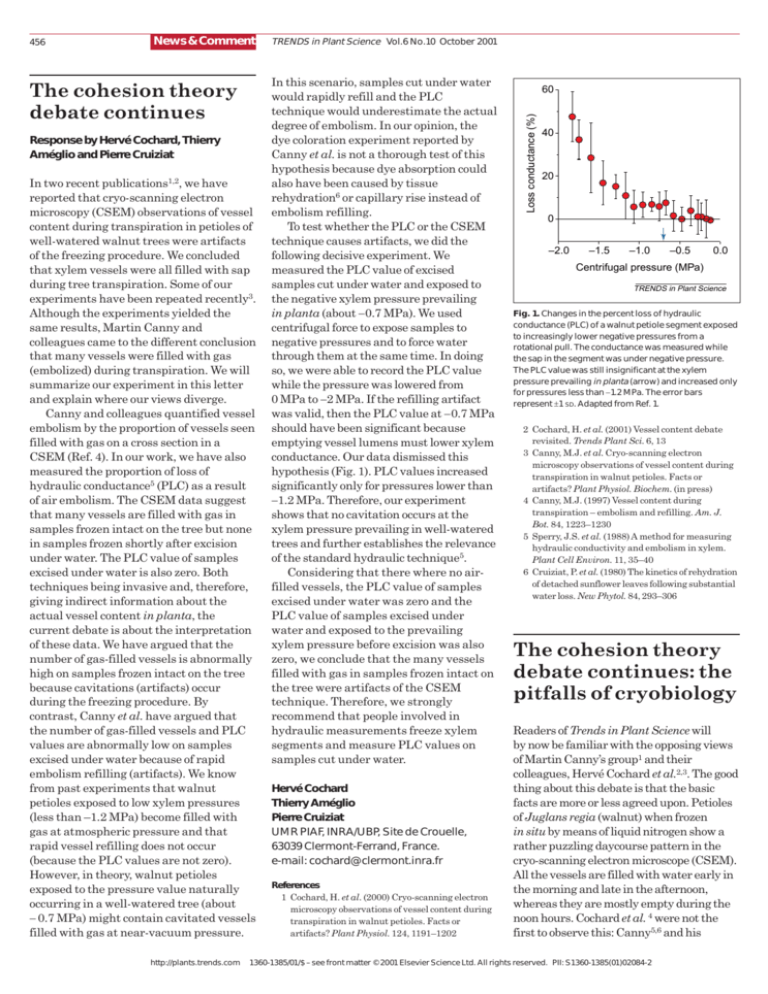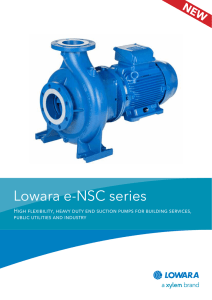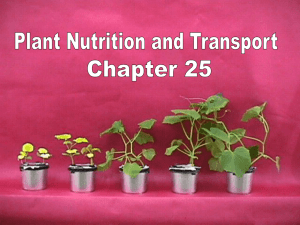
News & Comment
The cohesion theory
debate continues
Response by Hervé Cochard, Thierry
Améglio and Pierre Cruiziat
In two recent publications1,2, we have
reported that cryo-scanning electron
microscopy (CSEM) observations of vessel
content during transpiration in petioles of
well-watered walnut trees were artifacts
of the freezing procedure. We concluded
that xylem vessels were all filled with sap
during tree transpiration. Some of our
experiments have been repeated recently3.
Although the experiments yielded the
same results, Martin Canny and
colleagues came to the different conclusion
that many vessels were filled with gas
(embolized) during transpiration. We will
summarize our experiment in this letter
and explain where our views diverge.
Canny and colleagues quantified vessel
embolism by the proportion of vessels seen
filled with gas on a cross section in a
CSEM (Ref. 4). In our work, we have also
measured the proportion of loss of
hydraulic conductance5 (PLC) as a result
of air embolism. The CSEM data suggest
that many vessels are filled with gas in
samples frozen intact on the tree but none
in samples frozen shortly after excision
under water. The PLC value of samples
excised under water is also zero. Both
techniques being invasive and, therefore,
giving indirect information about the
actual vessel content in planta, the
current debate is about the interpretation
of these data. We have argued that the
number of gas-filled vessels is abnormally
high on samples frozen intact on the tree
because cavitations (artifacts) occur
during the freezing procedure. By
contrast, Canny et al. have argued that
the number of gas-filled vessels and PLC
values are abnormally low on samples
excised under water because of rapid
embolism refilling (artifacts). We know
from past experiments that walnut
petioles exposed to low xylem pressures
(less than –1.2 MPa) become filled with
gas at atmospheric pressure and that
rapid vessel refilling does not occur
(because the PLC values are not zero).
However, in theory, walnut petioles
exposed to the pressure value naturally
occurring in a well-watered tree (about
− 0.7 MPa) might contain cavitated vessels
filled with gas at near-vacuum pressure.
http://plants.trends.com
TRENDS in Plant Science Vol.6 No.10 October 2001
In this scenario, samples cut under water
would rapidly refill and the PLC
technique would underestimate the actual
degree of embolism. In our opinion, the
dye coloration experiment reported by
Canny et al. is not a thorough test of this
hypothesis because dye absorption could
also have been caused by tissue
rehydration6 or capillary rise instead of
embolism refilling.
To test whether the PLC or the CSEM
technique causes artifacts, we did the
following decisive experiment. We
measured the PLC value of excised
samples cut under water and exposed to
the negative xylem pressure prevailing
in planta (about −0.7 MPa). We used
centrifugal force to expose samples to
negative pressures and to force water
through them at the same time. In doing
so, we were able to record the PLC value
while the pressure was lowered from
0 MPa to −2 MPa. If the refilling artifact
was valid, then the PLC value at −0.7 MPa
should have been significant because
emptying vessel lumens must lower xylem
conductance. Our data dismissed this
hypothesis (Fig. 1). PLC values increased
significantly only for pressures lower than
−1.2 MPa. Therefore, our experiment
shows that no cavitation occurs at the
xylem pressure prevailing in well-watered
trees and further establishes the relevance
of the standard hydraulic technique5.
Considering that there where no airfilled vessels, the PLC value of samples
excised under water was zero and the
PLC value of samples excised under
water and exposed to the prevailing
xylem pressure before excision was also
zero, we conclude that the many vessels
filled with gas in samples frozen intact on
the tree were artifacts of the CSEM
technique. Therefore, we strongly
recommend that people involved in
hydraulic measurements freeze xylem
segments and measure PLC values on
samples cut under water.
Hervé Cochard
Thierry Améglio
Pierre Cruiziat
UMR PIAF, INRA/UBP, Site de Crouelle,
63039 Clermont-Ferrand, France.
e-mail: cochard@clermont.inra.fr
References
1 Cochard, H. et al. (2000) Cryo-scanning electron
microscopy observations of vessel content during
transpiration in walnut petioles. Facts or
artifacts? Plant Physiol. 124, 1191–1202
60
Loss conductance (%)
456
40
20
0
–2.0
–1.5
–1.0
–0.5
0.0
Centrifugal pressure (MPa)
TRENDS in Plant Science
Fig. 1. Changes in the percent loss of hydraulic
conductance (PLC) of a walnut petiole segment exposed
to increasingly lower negative pressures from a
rotational pull. The conductance was measured while
the sap in the segment was under negative pressure.
The PLC value was still insignificant at the xylem
pressure prevailing in planta (arrow) and increased only
for pressures less than −1.2 MPa. The error bars
represent ±1 SD. Adapted from Ref. 1.
2 Cochard, H. et al. (2001) Vessel content debate
revisited. Trends Plant Sci. 6, 13
3 Canny, M.J. et al. Cryo-scanning electron
microscopy observations of vessel content during
transpiration in walnut petioles. Facts or
artifacts? Plant Physiol. Biochem. (in press)
4 Canny, M.J. (1997) Vessel content during
transpiration – embolism and refilling. Am. J.
Bot. 84, 1223–1230
5 Sperry, J.S. et al. (1988) A method for measuring
hydraulic conductivity and embolism in xylem.
Plant Cell Environ. 11, 35–40
6 Cruiziat, P. et al. (1980) The kinetics of rehydration
of detached sunflower leaves following substantial
water loss. New Phytol. 84, 293–306
The cohesion theory
debate continues: the
pitfalls of cryobiology
Readers of Trends in Plant Science will
by now be familiar with the opposing views
of Martin Canny’s group1 and their
colleagues, Hervé Cochard et al.2,3. The good
thing about this debate is that the basic
facts are more or less agreed upon. Petioles
of Juglans regia (walnut) when frozen
in situ by means of liquid nitrogen show a
rather puzzling daycourse pattern in the
cryo-scanning electron microscope (CSEM).
All the vessels are filled with water early in
the morning and late in the afternoon,
whereas they are mostly empty during the
noon hours. Cochard et al. 4 were not the
first to observe this: Canny5,6 and his
1360-1385/01/$ – see front matter © 2001 Elsevier Science Ltd. All rights reserved. PII: S1360-1385(01)02084-2
News & Comment
TRENDS in Plant Science Vol.6 No.10 October 2001
co-workers7,8 repeatedly found such
daycourses in roots as well as leaves, and
they used them as an argument against the
cohesion–tension theory of water transport.
Those of us who have worked on
quantifying water transport, for example,
by means of heat balance methods or
transpiration studies, tend to be rather
perplexed by these findings. Diurnal
patterns of water volume transport in
plants are different. They show minima
during the night, in the morning and in
the evening, and a pronounced maximum
around noon of a sunny day. How, then, can
water for peak demand be conducted to the
evaporating leaves, when we are told that
conduits become empty just at the time
their transport capacity is needed most?
Cochard et al.4 presented several
experiments in an attempt to prove that the
voids in conduits observed in the CSEM
images are artefacts. Martin Canny and coworkers repeated part of these original
experiments. The latest stage of the
controversy is about an experiment
‘forgotten’ by Canny et al.1 in their
discussion, that is, the measurements of
conductivity on centrifuged petioles, which
these authors neither repeated nor
discussed. It is sometimes difficult to repeat
each and every experiment when you do
not have the equipment ready or have
experience in using a particular method. In
addition, we tend to overestimate the
importance of experiments we did
ourselves. A certain overestimation of an
obviously cherished experiment is also
visible in the dye-uptake study1, which
indeed does not prove that the colored
water was sucked into cavitation voids.
The conductivity measurements4 are of
crucial importance, because they tell us that
the minimum tension in the xylem water
column necessary for reducing hydraulic
conductivity is far higher than the one at
which empty vessels show up after freezing.
We are confronted with the following
dilemma: At tensions of about – 0.25 MPa,
cavitations become visible in the CSEM. For
a significant loss of hydraulic conductivity
we need tensions of at least −1.2 MPa.
The interpretation by Cochard et al. is
that freezing water will cause the water
column in the xylem to snap under tensions
not yet sufficient to cause cavitation by airseeding. I think that this interpretation is
supported by several independent facts.
(1) Winter freezing is one of the two major
mechanisms for embolization of xylem9 in
the field. We can therefore assume that
the growth of ice crystals in conduits leads
to cavitation and formation of emboli.
The phenomenon is not well studied at the
level of single conducting elements,
therefore there is little information about
the moment and the mechanism of
rupture of the water column.
(2) The overall cooling rate achieved
in the interior of petioles or roots by
immersion in liquid nitrogen or by contact
with cooled copper-jawed cryo-pliers must
be completely insufficient for vitrification
of the vessel fluid, which is almost pure
water. All other methods imaginable, such
as immersion into supercooled N2 or
precooled propane, would probably have
no better success: the cooling rate of water
in a trachea deep inside a petiole or a root
depends on the Biot number of the sample,
which is strongly influenced by its heat
conduction properties as well as by its
thickness10. (3) The heat conduction in
plant tissues is low whereas the diameter
of the plant organs under study was
excessive in comparison with successfully
vitrified specimens. Samples used in rapid
cooling procedures10 usually have a
volume of <0.25 mm3 , and even the most
sophisticated approaches do not keep
plant tissues ice-free to a depth of >0.6 mm
from the surface of the sample. Therefore,
it is no wonder that exotherms were
observed during ‘rapid’ cooling of walnut
petioles4. (4) Vitrification (immobilization
of water molecules in situ) would require a
cooling rate more rapid than −100°C s−1,
whereas the measured values correspond
to about −20°C s−1. However, only true
vitrification could potentially immobilize
the xylem sap in such a way that no gas
bubbles are released and, thus, no free
surfaces available for the explosive
evaporation of water vapor.
The resolution of a scanning electron
microscope is not high enough to show the
microcrystalline structure of the solid
vessel contents formed on immersion of a
petiole in liquid nitrogen.
Many of the conduits appear to be
partly filled with frozen water in the
CSEM images; they show droplets or
larger masses attached to the walls.
Canny’s group takes this ice as evidence for
cycles of cavitation and refilling. I share
the opinion4 that we see remnants of the
water column broken by freezing. Probably
they consist of the microcrystalline ice first
formed, which triggered a cavitation event
and led to the rapid withdrawal of yet
unfrozen water into neighboring conduits
http://plants.trends.com
457
still under tension or to uptake by living
cells. In various papers, the proportion of
fully or partly empty conduits was
estimated at up to 70% in a daycourse.
However, let us not forget that CSEM
images cannot give the true proportion of
cavitated conduits because they show only
cross-sections and not the whole length of
the tracheae. A cross-section completely
filled with ice is no evidence against voids
above or below the plane of sectioning;
the percentages estimated from direct
observations are thus minimum values.
In summary, all evidence makes it
plausible that the diurnal fluctuations in
the filling state of frozen tracheae are
artefacts. The counter-intuitive
assumption that vessels become empty
just when their transport capacity is
needed most can thus be replaced by a far
simpler sequence of events: water
transport through hydraulic resistances
leads to tensions, and freezing under
tension leads to visible cavitations.
Cochard et al.4 have, in my opinion, once
again shown that the cohesion–tension
theory of water transport is rather tough
and resilient. But so are its opponents.
Hanno Richter
Institut für Botanik, Universität für
Bodenkultur Wien, Gregor Mendel – Str. 33,
A-1180 Wien, Austria.
e-mail: h315t1@edv1.boku.ac.at
References
1 Canny, M.J. et al. (2001) The cohesion theory
debate continues. Trends Plant Sci. 6, 454–455
2 Cochard, H. et al. (2001) Vessel content debate
revisited. Trends Plant Sci. 6, 13
3 Cochard, H. et al. (2001) The cohesion theory
debate continues. Response by Hervé Cochard,
Thierry Améglio and Pierre Cruiziat. Trends
Plant Sci. 6, 457
4 Cochard, H. et al. (2000) Cryo-scanning electron
microscopy observations of vessel content during
transpiration in walnut petioles. Facts or
artifacts? Plant Physiology 124, 1191–1202
5 Canny, M.J. (1997) Vessel contents during
transpiration: embolisms and refilling.
Am. J. Bot. 84, 1223–1230
6 Canny, M. J. (1998) Applications of the
compensating pressure theory of water transport.
Am. J. Bot. 85, 897–909
7 McCully, M.E. et al. (1998) Daily embolism and
refilling of xylem vessels in the roots of fieldgrown maize. New Phytol. 138, 327–342
8 McCully, M.E. (1999) Root xylem embolisms and
refilling: relation to water potentials of soil, roots
and leaves, and osmotic potentials of root xylem
sap. Plant Physiology 119, 1001–1008
9 Tyree, M.T. and Sperry, J.S. (1989) Vulnerability
of xylem to cavitation and embolism. Annu. Rev.
Plant Physiol. Plant Mol. Biol. 40, 19–38
10 Echlin, P. (1992) Low-Temperature Microscopy
and Analysis, Plenum Press
1360-1385/01/$ – see front matter © 2001 Elsevier Science Ltd. All rights reserved. PII: S1360-1385(01)02047-7







